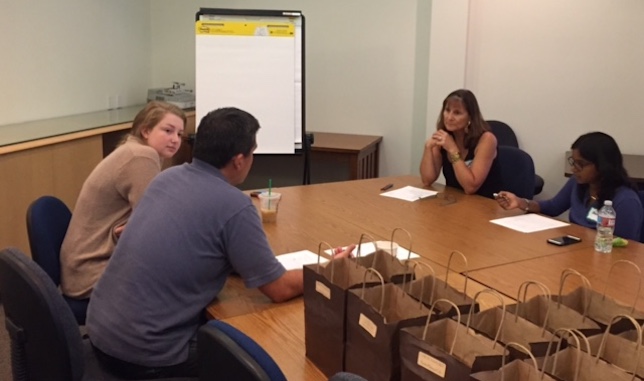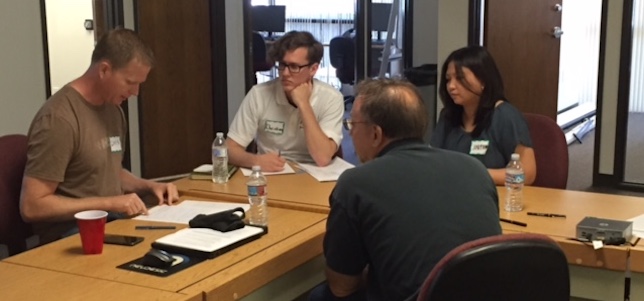Developing Guided Pathways in the Community College
A Q&A with Bob Bramucci and Jim Gaston
The push for student success, especially at community colleges, has given rise to a widespread interest in guided pathways models. Leading organizations like the American Association of Community Colleges have created guided pathways research to help community colleges understand and approach this significant movement at their own institutions. Partnerships like the California Guided Pathways Project are helping colleges forge ahead on implementing guided pathways programs.
But in a broader context, we watched as the notion of guided decision making — and the technologies that support it — emerged over time, embedded in a wide range of software tools. Here, CT talks with South Orange County Community College District IT leaders Bob Bramucci and Jim Gaston about the long history of decision support technology development at SOCCCD. They explain why guided pathways projects — that use technology tools like Sherpa, MAP, and Smart Schedule — are so important for community colleges now.

"I look at guided pathways as a decision choice architecture, arising out of the discipline of behavioral economics." — Bob Bramucci
Mary Grush: Why is SOCCCD developing technologies that support student success, drawing from some of the models we see in the guided pathways movement? How does this reflect the changing priorities of community colleges in general?
Bob Bramucci: We originally set up the community college system with the goal of access; to provide education to anyone in our community who could benefit from instruction — and that's nearly everyone. I think we did a very good job with the system we set up towards that goal. The California Community Colleges enroll more than two million students, and that means at least one out of every ten college students in California has been in the system at some point.
But as the goal changed, we moved the goal post. We are now more focused on success, as a result of some troubling statistics about how long it was taking students to complete their programs, or even the question of whether they would earn a certificate or succeeded in transfer at all.
Now, it's somewhat difficult to prioritize both success and access. For example, to provide access — "something for everyone" — we had created rather broad course catalogs. But when we needed to design community college offerings that emphasized student success, we had to try something new. Instead of having every student reinvent the wheel, so to speak — possibly choosing an indirect course or even getting off course from their goals — we needed to find the patterns that have been successful for students with common goals, and simplify the choices without limiting them. That's why we are so interested in guided pathways.
We still want to have comprehensive colleges that can offer very wide programs of study, and we don't want to make people march in lock-step with each other… but we need to help students make more effective choices.
Looking at all this from a software designer's viewpoint, if I am a system designer, there is probably going to be some error rate in my system. But if I design my system so that the least knowledgeable people using the it are making their own decisions, that's going to increase my error rate markedly. (More, rather than fewer people will be making bad decisions.) It could even sound like I'm saying we designed the system to increase the error rate — but of course, we didn't do that! Rather, we had simply designed it for access as the over-riding priority.
As a psychologist as well as a software designer, I look at guided pathways as a decision choice architecture, arising out of the discipline of behavioral economics. There is a large amount of research in that field showing how people can be overwhelmed by a wide array of choices. So, the way you present a hierarchy of choices to people can be critical in terms of the decisions they will make and the resulting effectiveness.
Grush: How did the SOCCCD development team approach guided pathways? What were some of the more specific issues you looked at, and what were some of the first steps you took? Also, why does technology play an important role?
Jim Gaston: In Fall 2015 and Spring 2016, we conducted a series of two-day Business Process Analysis (BPA) sessions with dozens of students, faculty, staff, and administrators from the two colleges in our district. We studied a host of business processes from admissions to registration and financial aid. On the first day of each BPA, we described an existing work process and mapped how the process flowed. We discovered that many of our business processes were outdated, with multiple redundancies and inefficiencies. Adding technology to such processes would simply result in faster bad processes!

In addition, the usability research with students conducted by our Student Design Team convinced us that the sheer number of options presented to incoming students is overwhelming and exacerbates poor decision-making. Colleges know this and typically provide enrichment resources to help students make wiser course decisions; however, we discovered that students "don't do optional" and often fail to avail themselves of these resources.
We don't want to decide for students. But we heard from the students themselves, over and over again, that they needed more structure around their decision making. This also makes sense at the level of system design, where — as Bob mentioned — pushing the most important actions down to the most numerous, error-prone element in a system acts to inflate the error rate. The fact is that students simply need more guidance to make good academic decisions and we are failing to give it to them.
We're suffering the consequences. A community college student who transfers to a baccalaureate institution typically takes 20 three-credit community college courses. Each course requires about 50 hours of time spent in class, but in addition prevents the student spending the same 50 hours in a class in which he or she could have succeeded. Thus, each poor course decision is a "double-whammy". It's like a demented video game where one only is allowed a handful of bad course decisions before dropping out—and if you're poor or from an underrepresented group, you get fewer turns.
We became convinced that students could make better decisions by reducing the bewildering number of choices we ask them to make, which is a main idea behind the guided pathways movement. But in addition, we believe that students also need a better decision support framework for the remaining decisions, and that's where technology shines. We think technology, and specifically the automation afforded by technology, has a huge role to play in how the information is presented to students and how they will make better academic decisions if we can deliver the right information, at the right time, in the right way, on the right device.
Grush: SOCCCD has been developing decision-support tools for a long time — starting way back in the early days of your MAP software and Sherpa! Sherpa was one of the early recommendation engines for students. What impact has Sherpa had at your colleges in the past five years since its implementation?
Gaston: Sherpa allows our colleges to create student "profiles" that group students who share similar characteristics—for example, "Does Not Have an Academic Plan". Once the profiles are created, college staff can send messages, called "nudges" or "nods", to that cohort group. The nudges are multi-modal and can be delivered via e-mail, SMS, or through MySite, our custom enterprise Web portal. Since Sherpa went live about five years ago we have sent over eight million nudges!

We're excited about how Sherpa has been embraced by our college community, but we're also concerned that we may be victims of our own success — that is, flooding students with too many messages. Other concerns are that nudges often arrive without the full context and that we need a way to better coordinate the nudges across the various departments.
So far, nudges have also been mostly transactional in nature — e.g., students are told they need to finish a step in matriculation or file some paperwork, or they may be reminded their registration appointment time is coming. We're interested in exploring how to use Sherpa in a few more intangible ways, such as increasing student engagement with the campus. We'll be exploring some of those ideas in the coming semester.
Grush: A more recent development at SOCCCD is SmartSchedule — I think we interviewed you regarding that about a year ago. How is that effort going? Is it fully implemented yet?
Gaston: SmartSchedule is a great example of we've been discussing as guided pathways. If you look at the class schedules at most universities and colleges, they're essentially just a dump of all the data that is available with little or no guidance presented to the student to help them make good decisions. Think about that for a minute — the class schedule is the actual place the student is making decisions that will have a huge impact on their academic success. Academic planning tools, like our My Academic Plan (MAP), are great services but they are ultimately theoretical, whereas the class schedule represents actual commitments.
Currently, the vast majority of course schedules either display every possible option or present a search form and expect the student to make the right selections without guidance. We're trying to remedy this with SmartSchedule. It's intended to be a personalized guide that will integrate with other planning tools to guide a student into making better-informed decisions.
This is a working product. The first phase went live in February and focused on making existing functionality more user friendly and mobile-responsive. The second phase will be delivered by the end of the year and will include intelligent search with auto-suggestion and faceted search results. The third and final phase will include a "Schedule Builder" wizard that will guide each student into a schedule optimized to meet his or her personal goals and time constraints.
Grush: You've worked on several tools that support guided pathways. I imagine you can build on what you learn from each one?
Bramucci: Yes, of course.
Grush: What about outreach? What might make it possible for you to offer tools like SmartSchedule to other institutions that may be interested in boosting their guided pathways efforts? And, where will you go next with SOCCCD development projects?
Bramucci: We are designing SmartSchedule to be a multi-tenant cloud service, so our hope is to eventually make it available to other institutions. We have begun some preliminary discussions with the State and a few vendors to explore our options and would welcome further discussions.

We just received funding for our next big project — the Student Success Roadmap. This will essentially be Sherpa 2.0 and is intended to address the issues Jim mentioned earlier. We want students to see the entire step-by-step process as one seamless continuum, from application through successful completion of their personal goals. The Roadmap will provide the context for each nudge and help students stay on the path to success. At this point we don't know exactly what it will look like because we have to finish some refinements to SmartSchedule first, but we're excited about the Student Success Roadmap and grateful we work for a district that values and encourages innovation.
[Editor's note: Images of design and development team work and the Sherpa logo courtesy SOCCCD.]